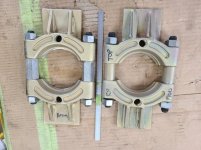Hi all.
I have been asked by a customer to provide clamping jaws to facilitate the removal of pressed on sleeves.
They are currently using a custom machined, bearing clamp / puller. (see attached pics)
The sleeves have a 0.100 x 0.0216" (radial depth) ring groove on the OD that will register the sleeve vertically, and not let the sleeve move up or down, as the shaft is pressed out.
I believe the force required to remove the shaft is around 2-4K lbs, so not bad.
The clamp will be machined to grab the sleeve in the groove, clamping on 350° of the OD. The clamp halves will meet at the 0.001-0.0015" after the sleeve OD is clamped.
My main question is this:
What is my best choice of material?
Tool Steel: O1, A1, D2, W1
Alloy Steel: 41XX, 52100, 5160, Cr-V?
I want to harden the tools to the Rc45-Rc50, and would love a stable material that will not move around much.
I also do not want the tool to break, bend, nor shear the mating portion of the clamp that interfaces with the radial groove on the sleeve.
Thanks,
Doug.


I have been asked by a customer to provide clamping jaws to facilitate the removal of pressed on sleeves.
They are currently using a custom machined, bearing clamp / puller. (see attached pics)
The sleeves have a 0.100 x 0.0216" (radial depth) ring groove on the OD that will register the sleeve vertically, and not let the sleeve move up or down, as the shaft is pressed out.
I believe the force required to remove the shaft is around 2-4K lbs, so not bad.
The clamp will be machined to grab the sleeve in the groove, clamping on 350° of the OD. The clamp halves will meet at the 0.001-0.0015" after the sleeve OD is clamped.
My main question is this:
What is my best choice of material?
Tool Steel: O1, A1, D2, W1
Alloy Steel: 41XX, 52100, 5160, Cr-V?
I want to harden the tools to the Rc45-Rc50, and would love a stable material that will not move around much.
I also do not want the tool to break, bend, nor shear the mating portion of the clamp that interfaces with the radial groove on the sleeve.
Thanks,
Doug.



